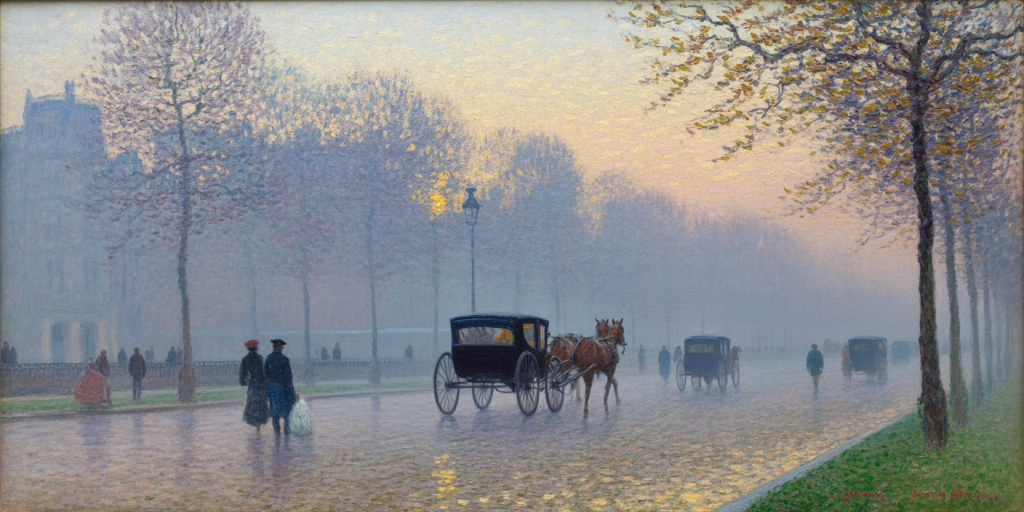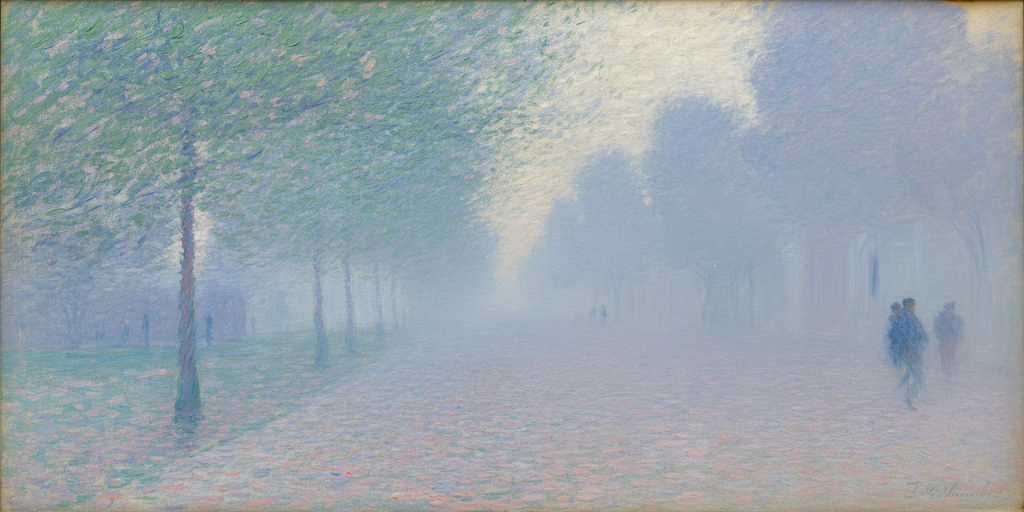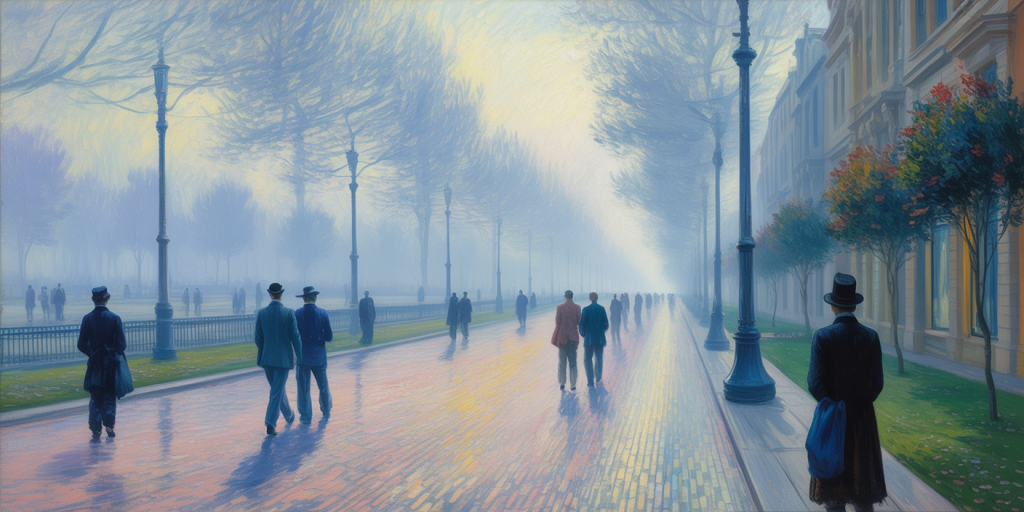Avenue in Fog: The Breath of a City According to Monet
In the heart of an early Parisian morning, when the mist rises from the cobblestones like breath from a sleeping mouth, Claude Monet painted silence. He did not portray streets or buildings as they were, but as they seemed—half-formed, vibrating with air, dissolving into atmosphere. In “Avenue in Fog,” the city exhales. Everything is in flux, suspended, hushed, as if time itself had momentarily lost its footing.
This is not a painting of a place, but of a sensation. It is the tremble between clarity and oblivion, between presence and absence. In Monet’s hands, the avenue becomes a veil, a lung, a passage through which the breath of the world travels. Looking into it is like trying to recall a dream while it still lingers in your chest.

Table of Contents
- The Whisper of the Morning Veil
- Colors that Breathe
- Where Form Dissolves
- The Pulse Beneath the Haze
- Trees as Sentinels of Stillness
- People as Shadows, Memory as Presence
- Mist and the Music of Absence
- The Blurred Edge of Reality
- Light that Sees Without Revealing
- The Fog as Emotional Topography
- Texture of the Invisible
- A City Without Borders
- The Avenue as Metaphor
- The Dance of Time and Air
- A Frame of the Subconscious
- When the Eye Surrenders
- Echoes in Pale Ochre
- The Hum of the Earth Through Paint
- Monet’s Brush as Breath
- The Silence Between Horse and Wheel
The Whisper of the Morning Veil
The fog in Monet’s work is not decoration. It is character. It moves, breathes, speaks. It wraps the city in a gauze of reverie, softening the known until it becomes unfamiliar. It invites a quiet that isn’t empty, but saturated with possibility.
Looking into the misted avenue, one does not see details—one feels them. The painting murmurs rather than declares. The veil of morning becomes a whisper to the senses, coaxing us to pause and listen to the in-between.
Colors that Breathe
Monet’s palette here is not of pigment, but of respiration. Pale lilacs, dusty golds, whispering greys. Each color exhales gently into the next, like breath shared between sleeping lovers.
The absence of sharp contrast allows colors to shimmer with life. They seem to float, to pulse. These hues are not chosen for drama, but for tenderness. They do not shout; they hum.
Where Form Dissolves
Buildings, figures, carriages—all melt. The solidity of architecture is abandoned in favor of impression. Form is a suggestion, not a certainty. This is not neglect but intention.
Monet uses dissolution to mimic perception: the way fog tricks the eye, how memory blurs. It is an honest mirror of sight filtered through feeling. Solidity is illusion; only sensation endures.
The Pulse Beneath the Haze
There is rhythm in this stillness. Though the scene appears paused, the air vibrates. The fog pulses with quiet life—the echo of hooves, the rustle of leaves, the sigh of distant voices.
This pulse is emotional, not literal. It is the throb of nostalgia, the beat of longing. Monet transforms the visual into the visceral, translating stillness into heartbeat.
Trees as Sentinels of Stillness
The trees lining the avenue are more than flora; they are guardians. Rooted in mist, they mark the rhythm of space. Their forms barely emerge, yet they anchor the painting.
These trees suggest structure without imposing it. They offer a frame for the amorphous, like ribs around a lung. Their subtle presence grants gravity to the ephemeral.
People as Shadows, Memory as Presence
Figures drift through the scene like dreams. They are faceless, floating. We do not know who they are—perhaps even Monet did not know. They are less subjects than echoes.
This anonymity invites projection. The viewer becomes the wanderer. The figures function as memory: indistinct, moving, always receding. Their vagueness is their truth.
Mist and the Music of Absence
What we do not see in the painting is just as potent as what we do. The mist is full of absence: of streets not yet seen, of details swallowed by light. It becomes an orchestra of silence.
Absence in Monet is not void. It is vibration. The lack becomes sound—a music only the soul can hear. It is the quiet between notes, the breath between thoughts.
The Blurred Edge of Reality
Monet does not delineate the edge. He blurs it. Street meets sky without a seam. Trees become clouds. Man becomes environment. This is the soft collision of reality and reverie.
His technique mirrors consciousness. Just as thought flows into dream, so does street into mist. The boundaries we rely on dissolve. We are asked to feel, not to name.
Light that Sees Without Revealing
There is light in this painting, but not clarity. It illuminates the fog, not the form. It touches gently, refusing to interrogate. It is the light of empathy.
This is not sunlight that shows the world, but that blesses it. It gilds the mist, making sacred the mundane. The avenue becomes a chapel of air.
The Fog as Emotional Topography
Fog becomes emotion rendered visible. It stands in for melancholy, for wonder, for uncertainty. It fills the space between heartbeats with luminous weight.
Each brushstroke is a breath. Each wisp of haze is a feeling half-formed. The avenue is no longer geography; it is psyche.
Texture of the Invisible
There is texture in this intangibility. Monet’s brushwork is soft, but certain. The paint moves like fog itself: drifting, settling, vanishing. The canvas breathes.
You can feel the air on your skin. The painting becomes tactile despite its vagueness. This paradox is the soul of impressionism.
A City Without Borders
Paris here has no edges. No signs, no advertisements. It is stripped of identity yet becomes more universal. The city becomes archetype—every city, every morning, every moment before waking.
In this anonymity lies intimacy. The lack of specifics makes the emotion sharper. We are not looking at a city; we are remembering one.
The Avenue as Metaphor
This road is not merely a path; it is metaphor. For time, for consciousness, for life drifting through fog. We travel it not with feet, but with feeling.
Its direction is unclear, but its presence is unwavering. The avenue asks no questions, offers no answers. It simply is.
The Dance of Time and Air
Time in this painting does not march; it waltzes. It drifts, spins, floats. There is no urgency, only rhythm. The fog stretches seconds into eternities.
Monet paints not a moment, but the breath of a moment. He suspends us in a dance of vapor and vision.
A Frame of the Subconscious
This scene could be a dream. It could be a memory not ours. Monet opens a door into the subconscious, using fog as key.
What we see on the canvas is not just external. It is internal. It is a mental landscape. A visual diary of sensation.
When the Eye Surrenders
There is a point in viewing Monet where the eye gives up. It can no longer grasp outlines. It begins to feel instead of analyze.
This surrender is liberation. We are freed from form, from logic. We enter a state of perceptual meditation. The painting becomes a mantra of air.
Echoes in Pale Ochre
Certain tones repeat like whispers. Pale ochres, light violets, subtle greens. These echoes build resonance. They create visual memory.
Like a song with recurring motifs, these colors guide our emotional journey. They are not decoration, but language.
The Hum of the Earth Through Paint
The silence of this street hums. There is energy beneath the fog—a slow, deep vibration. It is the earth itself breathing.
Monet tunes into this hum. His painting is an act of listening. The brush becomes an ear. The canvas, a record of breath.
Monet’s Brush as Breath
His technique is both precise and ephemeral. Dabs of paint behave like gusts. Brushstrokes curve like sighs. There is no harshness, only exhale.
This is not depiction; it is inhalation. Each stroke is a moment drawn into the lungs and released onto canvas.
The Silence Between Horse and Wheel
Even the carriages in the distance make no sound. Their motion is implied, not heard. They glide like thoughts half-spoken.
The painting holds its breath. We wait for a sound that never comes. This silence is not emptiness. It is the fullness of stillness.

FAQ
Who was Claude Monet?
A founding figure of the Impressionist movement, Monet sought to capture the fleeting effects of light and atmosphere in everyday scenes.
What is special about his fog paintings?
They dissolve form in favor of emotion, using mist and light to evoke the ephemeral nature of perception.
Is ‘Avenue in Fog’ a real painting?
It is a poetic interpretation inspired by Monet’s fog-filled urban landscapes, such as his views of the Thames and Paris.
What makes this piece unique?
Its dedication to mood over form. It doesn’t seek to represent but to evoke—to conjure sensation through visual breath.
Why does it feel so emotional?
Because it mirrors the human condition: uncertain, soft-edged, always in transition. The fog becomes a metaphor for being.
What technique did Monet use?
Short, broken brushstrokes. Layering of color. Wet-on-wet paint. He built atmosphere through cumulative softness.
What movement did he inspire?
Impressionism, Post-Impressionism, and later abstraction all carry traces of his atmospheric daring.
Was he appreciated in his time?
Eventually, yes. Though first ridiculed, Monet became a leading figure in transforming modern art.
Final Reflections: Breathing the City with Light
Monet teaches us to see not with the eye, but with the chest. His cityscapes do not depict places; they exhale them. “Avenue in Fog” is less a painting than an act of breathing, of dreaming with the eyes open.
He invites us to walk into the mist, to lose the boundaries, to become part of the air. We are not outside the painting; we are within it, fog-bound and luminous.
In a world obsessed with clarity, Monet dares to blur. In doing so, he reveals something deeper: that truth is often hidden in the haze, and sometimes, to see clearly, we must first let go of the need to see at all.

